10.03.2018
It’s been a month and a half since Rocket Lab sent a sparkly satellite called Humanity Star into orbit, but we’re just now getting into prime time for seeing it from the western United States.
Humanity Star is a geodesic sphere made of carbon fiber and covered with 65 reflective panels, designed specifically to twinkle in dark skies as all those panels reflect sunlight before dawn and after dusk.
The 39-inch-wide (meter-wide) satellite was sent into a nearly pole-to-pole orbit from New Zealand aboard Rocket Lab’s low-cost Electron launch vehicle in January, along with three small Earth observation satellites.
Sighting conditions depend on where the satellite is during the optimal times for viewing. During the day, of course, the satellite’s reflections are lost in the sun’s glare. During the depths of night, the satellite isn’t at the right angle to reflect sunlight.
It took until early March for Humanity Star to get into the optimal orbital phase for West Coast sightings. Between now and March 27, there should be at least one sighting opportunity every day over Seattle. Another string of sightings is due to begin on May 7.
Humanity Star’s website tracks where the satellite is at any given time, and you can enter your location to find out the next time it’ll be over your locale.
The best way to plan your sighting is to plug your coordinates into Heavens-Above.com, a website that tracks not only Rocket Lab’s satellite, but the International Space Station and other sky objects as well. If you do it right, you’ll get a minute-by-minute map tracing the sparkle in the night sky.
Tonight it’s visible over Seattle for about five minutes, starting at 7:15 p.m. PT. Saturday night’s viewing opportunity runs from 7:32 to 7:38 p.m. PT.

The idea of putting one more blinkin’ object in the sky, for no other reason than to see it, rubs some astronomers the wrong way. But Rocket Lab didn’t mean to cause a nuisance. Instead, CEO Peter Beck said he intended the highly reflective object to spark reflection on Earth as well.
“My hope is that all those looking up at it will look past it to the vast expanse of the universe and think a little differently about their lives, actions and what is important for humanity,” he said in a post-launch news release.
If you’re one of those who’s bugged by the potential for light pollution or orbital debris, this too shall pass. The composition, size and altitude of Humanity Star is such that it should descend to a fiery atmospheric re-entry and burn up completely within eight months or so.
Update for 7:35 p.m. PT March 9: When Humanity Star was launched, Rocket Lab said it could well rank as one of the brightest satellites in the sky, but science writer Dave Dickinson reports that the darn thing can be tough to spot:
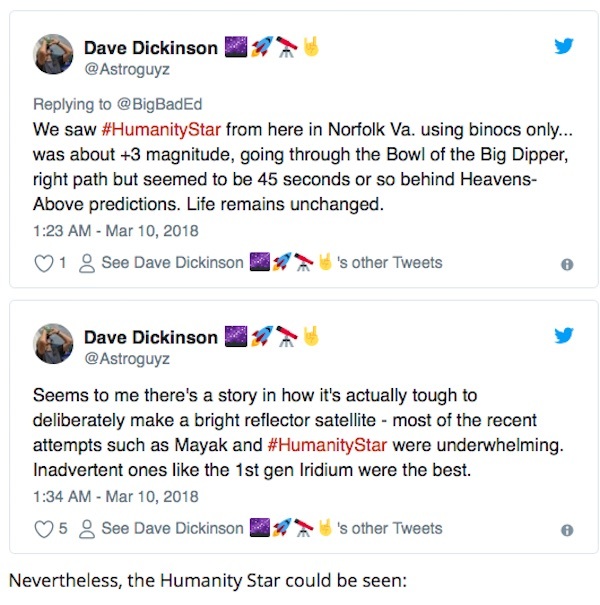
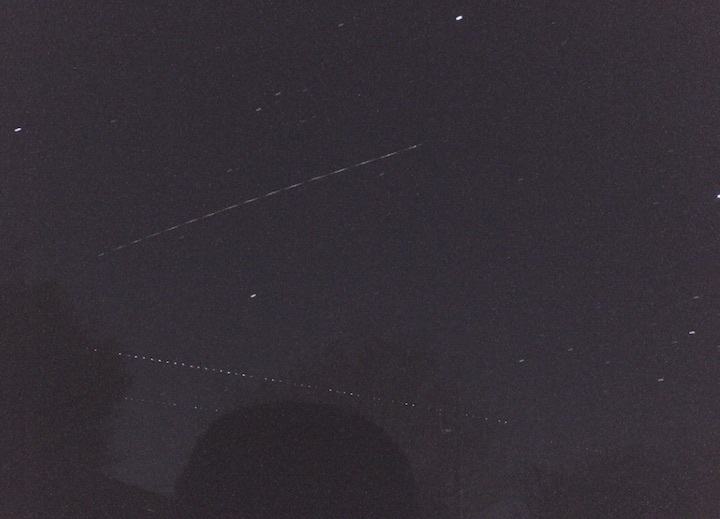
It’s been a month and a half since Rocket Lab sent a sparkly satellite called Humanity Star into orbit, but we’re just now getting into prime time for seeing it from the western United States.
Humanity Star is a geodesic sphere made of carbon fiber and covered with 65 reflective panels, designed specifically to twinkle in dark skies as all those panels reflect sunlight before dawn and after dusk.
The 39-inch-wide (meter-wide) satellite was sent into a nearly pole-to-pole orbit from New Zealand aboard Rocket Lab’s low-cost Electron launch vehicle in January, along with three small Earth observation satellites.
Sighting conditions depend on where the satellite is during the optimal times for viewing. During the day, of course, the satellite’s reflections are lost in the sun’s glare. During the depths of night, the satellite isn’t at the right angle to reflect sunlight.
It took until early March for Humanity Star to get into the optimal orbital phase for West Coast sightings. Between now and March 27, there should be at least one sighting opportunity every day over Seattle. Another string of sightings is due to begin on May 7.
Humanity Star’s website tracks where the satellite is at any given time, and you can enter your location to find out the next time it’ll be over your locale.
The best way to plan your sighting is to plug your coordinates into Heavens-Above.com, a website that tracks not only Rocket Lab’s satellite, but the International Space Station and other sky objects as well. If you do it right, you’ll get a minute-by-minute map tracing the sparkle in the night sky.
Tonight it’s visible over Seattle for about five minutes, starting at 7:15 p.m. PT. Saturday night’s viewing opportunity runs from 7:32 to 7:38 p.m. PT.

The idea of putting one more blinkin’ object in the sky, for no other reason than to see it, rubs some astronomers the wrong way. But Rocket Lab didn’t mean to cause a nuisance. Instead, CEO Peter Beck said he intended the highly reflective object to spark reflection on Earth as well.
“My hope is that all those looking up at it will look past it to the vast expanse of the universe and think a little differently about their lives, actions and what is important for humanity,” he said in a post-launch news release.
If you’re one of those who’s bugged by the potential for light pollution or orbital debris, this too shall pass. The composition, size and altitude of Humanity Star is such that it should descend to a fiery atmospheric re-entry and burn up completely within eight months or so.
Update for 7:35 p.m. PT March 9: When Humanity Star was launched, Rocket Lab said it could well rank as one of the brightest satellites in the sky, but science writer Dave Dickinson reports that the darn thing can be tough to spot:
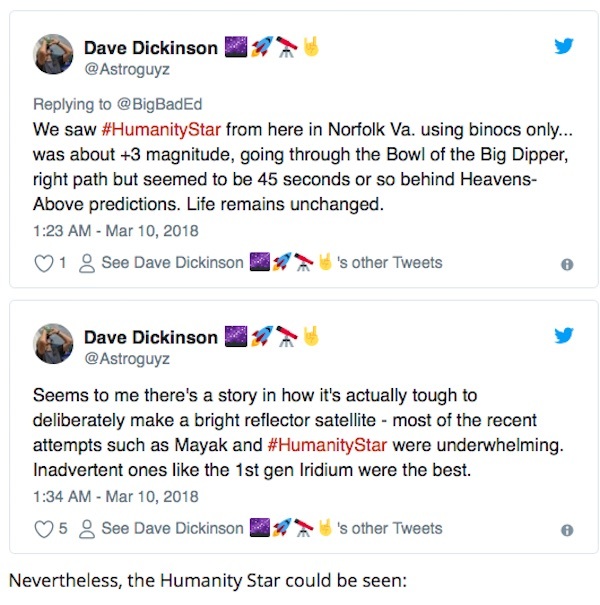
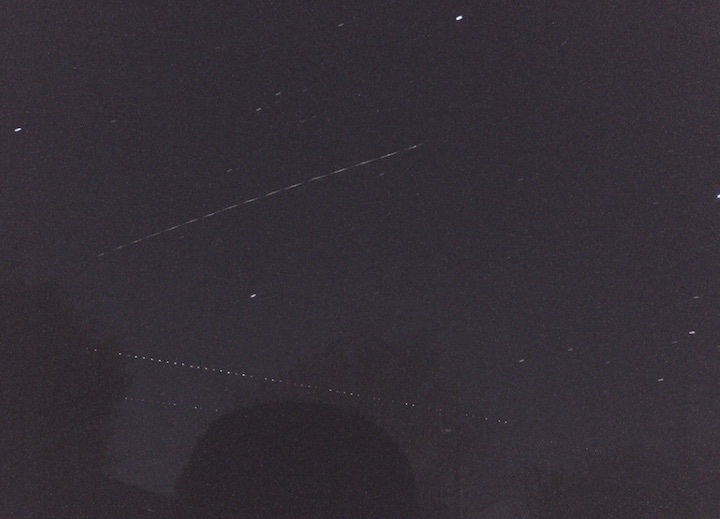
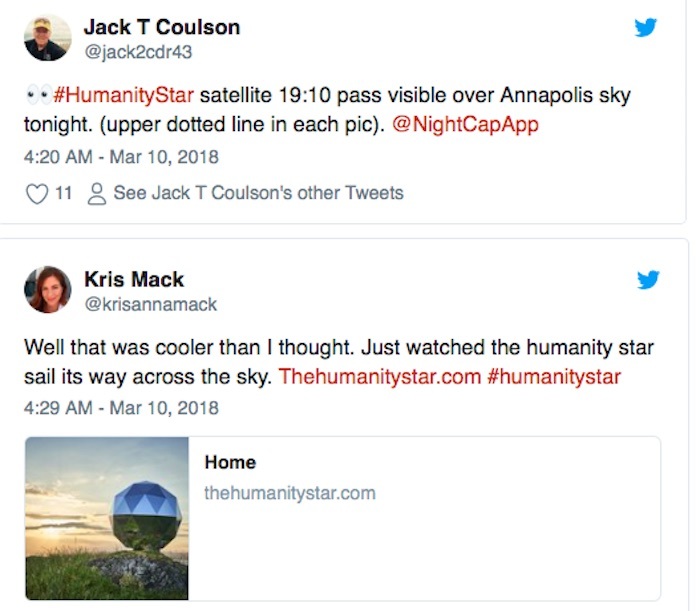
Quelle: GeekWire
